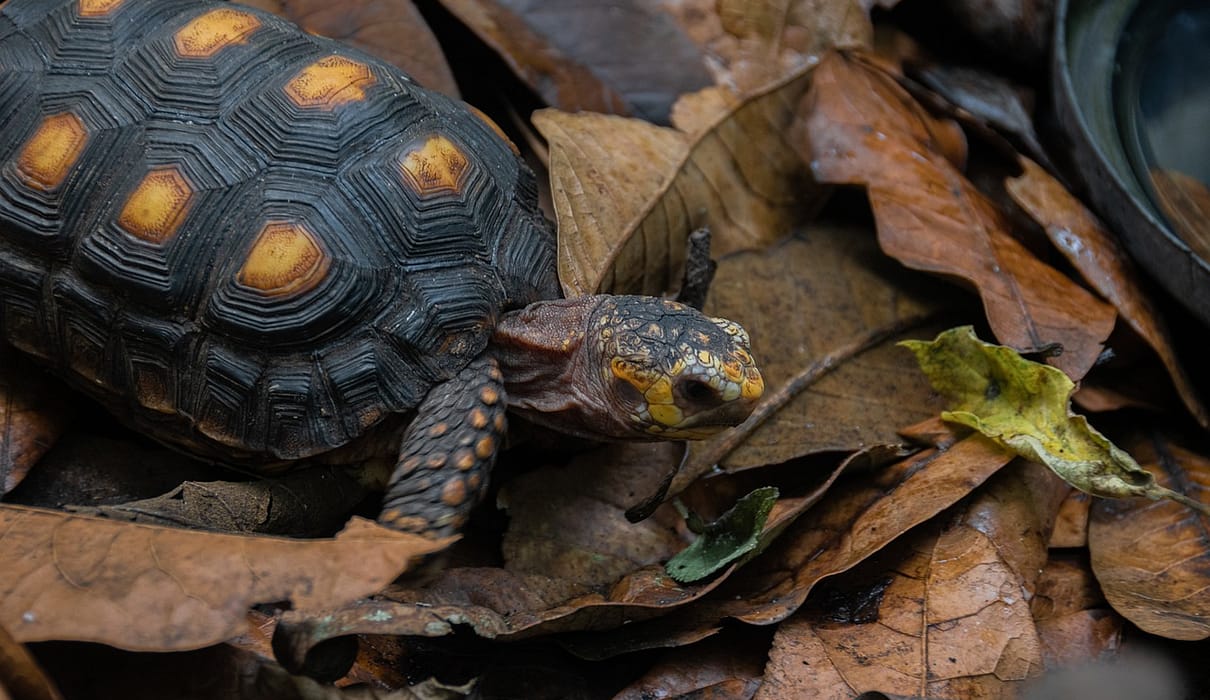The Red-Footed Tortoise is an enchanting reptilian species native to the lush tropical regions of South and Central America. Their striking coloration, moderate size, and gentle demeanor have made them popular pets among reptile enthusiasts worldwide. This comprehensive guide aims to provide you with essential insights on Red-Footed Tortoise care, ensuring your tortoise thrives in its captive environment.
Table of Contents
Understanding the Red-Footed Tortoise
Taxonomy and Natural Habitat
The Red-Footed Tortoise, scientifically known as Chelonoidis carbonaria, is part of the Testudinidae family and the Chelonoidis genus. In the wild, they flourish in a wide range of habitats, from grasslands to the rainforests around the Amazon basin. These moderately-sized tortoises are known for their striking coloration, featuring vibrant red or orange scales on their legs and head, and a dark-colored carapace (shell).
Physical Characteristics and Lifespan
Red-Footed Tortoises exhibit an impressive lifespan that extends beyond 50 years, with some individuals even reaching the 80-year mark. The size of an adult Red-Footed Tortoise generally falls between 11 to 14 inches in length, with some reaching up to 18 inches. They possess a high-domed, oval carapace adorned with distinctive growth rings on each scute (bony plate).
Behavioral Traits
These tortoises are fairly solitary in nature but display a curious and gentle demeanor. While they are not overly fond of being handled, they often exhibit a tolerance towards human interaction, making them a favorite among reptile keepers. Unlike other tortoise species, Red-Footed Tortoises can live harmoniously in groups, given there’s enough space and resources.
Establishing a Suitable Enclosure
Enclosure Size and Type
The enclosure for your Red-Footed Tortoise should offer ample space for movement, burrowing, and exploring. For hatchlings and young tortoises, a 40-gallon tank or its equivalent could suffice. However, as they grow, the enclosure needs to be expanded. For a fully-grown adult, an enclosure measuring a minimum of 8 by 4 feet is recommended.
Substrate Selection
Creating a comfortable and naturalistic substrate is crucial for your tortoise’s well-being. Opt for substrates that retain moisture well, such as coconut coir, peat moss, or cypress mulch. Ensure the substrate is deep enough for burrowing activities.
Enclosure Accessories
Decorate the enclosure with various accessories like flat rocks, driftwood, and plants to create a stimulating environment. Provide multiple hide boxes and burrows at different temperatures to cater to your tortoise’s thermoregulation needs. Always ensure a large, shallow water dish is available for drinking and soaking.
Maintaining Optimal Temperature and Humidity
Temperature Requirements
Red-Footed Tortoises thrive in temperatures between 74 and 80 degrees Fahrenheit, with a basking area heated to around 90 degrees. Maintaining a thermal gradient in the enclosure, with a warm side and a cooler side, allows your tortoise to self-regulate its body temperature.
Humidity Requirements
Being a rainforest species, Red-Footed Tortoises require high levels of humidity. Strive to maintain humidity levels between 50% to 70% in the enclosure. Remember to regularly mist the enclosure and maintain a damp substrate to help achieve the desired humidity.
Lighting and Heating
UVB Lighting
UVB lighting is crucial for the health of your Red-Footed Tortoise. It helps in the metabolism of calcium and the synthesis of vitamin D3, promoting healthy bone and shell development. A Tropical UVB bulb, placed no more than 24 inches from the tortoise, should suffice. Remember to replace the bulb every 6-12 months for optimal output.
Heating
Heating elements such as ceramic heat emitters can be used to maintain the required temperatures. However, avoid under-tank heaters as they can interfere with the tortoise’s digestion and reproductive health. Ensure all heating elements are regulated by a thermostat to prevent overheating.
Feeding Your Red-Footed Tortoise
Dietary Requirements
Red-Footed Tortoises have a diverse diet that leans towards herbivorous, with a small inclusion of animal protein. Their diet should comprise a mix of leafy greens, vegetables, and fruits. Supplement their diet occasionally with earthworms, superworms, or dubia roaches for protein.
Feeding Schedule and Supplements
Feed young Red-Footed Tortoises daily and adults every other day. Supplement their meals with calcium and vitamin D3, 2-3 times a week, to boost their nutrient intake. Ensure fresh water is always available in the enclosure.
Regular Cleaning and Health Check-ups
Cleaning the Enclosure
Regular cleaning is crucial to prevent the build-up of harmful bacteria. Spot clean the enclosure daily, removing any leftover food or waste. Deep clean the entire enclosure every few months, replacing the substrate and disinfecting the decor.
Health Check-ups
Regular health check-ups with a qualified herpetological vet are essential. Watch out for signs of illness such as changes in appetite, lethargy, and abnormal feces. Promptly seek veterinary assistance if any health concerns arise.
Handling Your Red-Footed Tortoise
While these tortoises are relatively tolerant to handling, it’s important to approach them gently and avoid handling them excessively. Always wash your hands before and after handling your tortoise to prevent the transmission of diseases.
In conclusion, providing the best Red-Footed Tortoise care involves creating an optimal living environment, offering a balanced diet, and ensuring regular health check-ups. Remember, owning a tortoise is a long-term commitment, and these captivating creatures can bring joy and fascination to your life for many decades with the right care.

